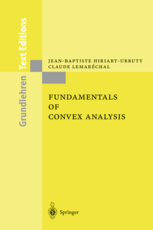CO463/663 Fall 2012
Convex Optimization and Analysis
- "The great watershed in optimization is not
between linearity and nonlinearity, but convexity and nonconvexity."
(Rockafellar, 1993.)
Instructor Henry Wolkowicz (MC6065, x35589)
- Handouts
- Syllabus Course/Marking
- Links/Announcements
- A new algorithm that minimizes anything/everything
- 200 Best Jobs in America 2011 and 2010
- Time: TR 11:30-1:00PM
- Location: MC 4060
-
Office Hours: Tues. 2-3PM
- FINAL EXAM: Thursday, Dec. 6, 12:30-3:00PM, RCH 209 (You may bring one 8.5-by-11 sheet of paper with handwritten notes.)
-
J.-B. Hiriart-Urruty and C. Lemaréchal,
Fundamentals of Convex Analysis,
Springer, 2001
(available at reserve desk; 3 hour reserve)
Expect 6 assignments - to be submitted at the beginning of the class stated on the assignment.
HW1; HW2; HW3; HW4; HW5; HW6 ;
-
Homework #1
- Due: Thursday, Sept. 27, 2012
-
Reading
- For your interest only:
-
Problems/Tasks
- Download and install cvx. (We will experiment with this during the course to solve Disciplined Convex Programming Problems.) (You can access MATLAB directly on the nexus machines or one of the cpu servers such as cpu125.student.math or cpu09.student.math. And also fe03.student.math, fe07.student.math, cpu03.student.math, see the list)
- Consider the MATLAB file: closest_toeplitz_psd.m. Run this file with the current data. Then, remove the % to uncomment the two lines that generate a random example. Run the file again. Hand in your P,Z matrices and the error for each run.
- Solve the Problems and Solutions- Addendum/Correction to prob. 5b)
- Homework #2
Problems and solutions - , Due: Tuesday, Oct. 9, 2012- Homework #3
Due: Thursday, Oct. 18, 2012- Problems AND Solutions -
-
CVX Problem: (Note: There is a typo in problem 4: $\alpha \geq
0$ is missing.)
- consider the SDP relaxation of the max-cut problem discussed in class. Solve the dual of the relaxation using CVX. Let y,X denote the optimum of the dual and primal, respectively.
- Generate random data as input, i.e. generate random nonnegative weights for the graph and input the Laplacian L as data for the SDP problem.
- Find an (approximate) solution x for the original max-cut problem and calculate a percentage error.
- Hand in (or email) your cvx program and: L; primal dual optimal y, X; the approximate x; and the percentage error.
- Perform the above for dimension n=3,5,10
- Homework #4
, a symmetric matrix with constant 'diagonals'. Check the accuracy of your solutions, e.g. is the optimum you found positive semidefinite; are the primal and dual optimal values equal?- Problems and solutions, (typo in problem 1; C is convex set) Due: Thursday, Nov. 1, 2012
-
CVX Problem for this assign.
- Use CVX to solve the closest correlation matrix problem, i.e. generate a random symmetric n by n matrix X (try n=5,10,100) and find a closest matrix in the intersection of: the cone of positive semidefinite matrices and the subspace of symmetric matrices with diagonal all ones.
- Try and do the same for finding the nearest symmetric positive semidefinite http://en.wikipedia.org/wiki/Toeplitz_matrix Toeplitz matrix
- Homework #5 problems and solutions, Handed out: Tuesday Nov. 6; Due: Thursday, Nov. 15, 2012 (at start of class)
- Homework #6 with solutions, Handed out: Tuesday Nov. 20; Due: Thursday, Nov. 29, 2012 (at start of class)
-
(Hint for problem 1:
Use the following result from Linear Programming:
assume that $u,u^1,,\ldots,u^p$ are vectors in $\R^q$
If $u$ is a nonnegative combination of $u^1,\ldots, u^p$, then it must
be a nonnegative combination of no more than $q$ of these vectors.
(This follows from the definition of BFS in LP,
basic feasible solution in Linear Programming)
-
(Hint/Outline for problem 7:
\begin{enumerate}
\item
A convex function $f$ has bounded lower level sets if, and only if,
it satisfies the growth condition
\[
\liminf_{\|x\|\rightarrow \infty}
\frac {f(x)}{\|x\|} >0.
\]
\item
Since $f$ is closed, it is bounded below on compact sets.
\item
Therefore, the above inequality is equivalent to the existence of a
minorant of the form $\epsilon \| \cdot \|+k \leq f(\cdot)$ for some
constants $\epsilon >0$ and $k$.
\item
Taking conjugates, shows that this is equivalent to $f^*$ being
bounded above on a neighbourhood of $0$, which in turn is equivalent to
$f^*$ being continuous at $0$.
\end{enumerate}




